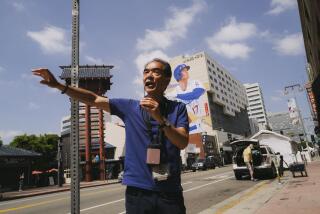Near Fukushima, Japan, famed mayor loses residentsâ support
Reporting from Minamisoma, Japan â For a time, he was the worldâs angriest mayor, an Internet sensation who publicly lashed out at Japanâs government for abandoning his town as the stricken Fukushima Daiichi nuclear power plant spewed radiation just a few miles away.
Months later, as people come to grips with the hard work of getting on with their lives, there is still plenty of anger and frustration in Minamisoma. But now, much of it is directed at Mayor Katsunobu Sakurai.
Residents say fame went to his head, that heâs pushing too hard for people to come back to this town 15 miles north of the still-ailing power plant.
Sakurai acknowledges their criticism, but insists that whatâs really at stake is the townâs survival.
In an 11-minute homemade video posted on YouTube after the Fukushima accident in March, Sakurai pleaded for outside help as fleeing residents turned Minamisoma into a nuclear ghost town.
Without timely information from the government or Tokyo Electric Power Co., the utility that runs the plant, he said, âwe are left isolated ⌠and are being forced into starvation. I beg you from my heart to help us.â
The dispatch drew a worldwide response, causing many to wonder how Japan could forsake its most vulnerable residents. Chastened officials gave Sakurai a special telephone number to the central governmentâs halls of power.
Nearly nine months later, Sakuraiâs temperament hasnât changed.
âIâm still angry,â said the impish, balding 56-year-old mayor, dressed on a recent day in a light-gray jumpsuit with penholders on the sleeves. âBut now the problem isnât the government; itâs the utility officials who refuse to help my town.â
Radiation levels have begun to diminish in Minamisoma, which two-thirds of the 71,000 residents fled after the accident. Areas once declared unsafe are being reopened. Nowadays 42,000 people are trying to rebuild businesses and family lives here.
Yet continuing hard times in Minamisoma engender plenty of hard feelings. Residents say the nuclear cleanup is moving too slowly, and they flinch at mounting government bureaucracy.
But the most pointed criticism is directed at their mayor.
After Sakurai in April made Time magazineâs list of the worldâs 100 most influential people as an icon of recovery, the tide at home began to turn. Business leaders who once supported him said he was becoming too full of himself. âItâs gone to his head,â said Oka Hiroyuki, owner of the Dragonfly Cafe. âPeople are losing faith in him.â
Many ridicule his plan that calls for residents to take an active part in reviving the town and building its spirit.
Although many surrounding towns are pushing the utility to clear away surface dirt tainted with radioactivity and perform other cleanup work before residents come back, Sakurai is also preaching self-help. The work will go much faster if people who live in Minamisoma pitch in, he says.
Sakuraiâs idea is to organize citizen work crews to get things started, but he wants to wait until more residents return so that the job will go faster.
Hiroyuki wants nothing to do with any work detail.
âOther evacuated towns insist the utility that caused the mess make things safe before residents return,â he said. âBut our mayor is too brash. He wants people back at any cost.â
Young people have left to start new lives elsewhere, but older residents insist on staying put, bonded to the land and the town where they were born. The result: In a nation where multi-generation households are common, grandparents are being separated from their children and grandchildren.
âParents of small children are afraid of the radiation, so they have fled, leaving behind the old folks with broken hearts, the ones who are too old or too stubborn to leave,â said Yuriko Hoshi, a town resident.
A woman in her early 50s whose family runs a gardening business, Hoshi says she has no alternative but to stay. Yet she worries that the piles of rubble that linger here are laced with radioactive isotopes that will one day harm her.
âThose of us who stay just have to learn to get used to radiation, no matter how safe the government says it is,â she said. âThereâs nothing else we can do.â
In this town of orderly houses within sight of the sea, Sakurai acknowledges that he has heard the whispers. But he remains unbowed.
âPeople think I consider myself a big shot,â he said, sitting beneath a banner reading, âLetâs keep going Minamisoma.â âBut my celebrity has given me the ear of government ministers, and that will help this townâs recovery.â
The ground floor of Minamisomaâs tiny City Hall is still packed with residents completing municipal paperwork for aid or to reclaim businesses that had been declared unsafe. Many sit with bewildered looks, nodding to neighbors who pass by.
As his wife, Minami, filled out a 10-page form, 39-year-old Osamu Watanabe struggled to contain his 4-month-old daughter, Kokomi, as she squirmed in his arms.
The area where their business lies has recently been cleared for people to visit, and city officials are allowing only several people each day to go to the area, creating a backlog of anxious residents who must first fill out a mountain of paperwork.
Although cumbersome forms are a normal part of Japanese culture, the detail-oriented Sakurai has gone even further, to the chagrin of many residents.
âWe just want to return to our supermarket for some computers and we have to fill out all these forms,â Watanabe said. âThe mayor has created too much bureaucracy.â
Others accuse Tokyo Electric Power Co., known as Tepco, of erecting bureaucratic walls to avoid delivering promised payouts. Hoshi cashed a check for $13,000 the utility issued as an âapologyâ payment for the nuclear plant disaster. But a more sizable payment requires completing scores of pages of detailed documents.
âWeâre intimated by all the paperwork, so we may just not file at all. I think thatâs the way Tepco wants it,â she said.
Sakurai calls the utility his townâs newest Enemy No. 1. âTheyâre throwing money at people to make them go away,â he said. âIâve told Tokyo that Tepco has to be made more accountable, that theyâre hiding behind the governmentâs skirts.â
But Sakurai has another target for his anger as well: town residents who he says have turned their backs on him.
âToo many people just want to play victim and leave the cleanup to Tepco and the government,â he said. âPeople have to pitch in to make this work.â
âMost complaints come from people who evacuated, who ran away from this town,â he said. âIâve been here from the beginning. And Iâve learned that recovery isnât as easy as people think.â
The actions of people like cafe owner Hiroyuki and his wife, who moved to a nearby town and return to run their business and check in on his elderly parents, may well kill Minamisoma, he said.
âIâm not forcing people to return,â Sakurai said. âIâm just insisting that our town is still livable, that we can improve it together.â
More to Read
Sign up for Essential California
The most important California stories and recommendations in your inbox every morning.
You may occasionally receive promotional content from the Los Angeles Times.











